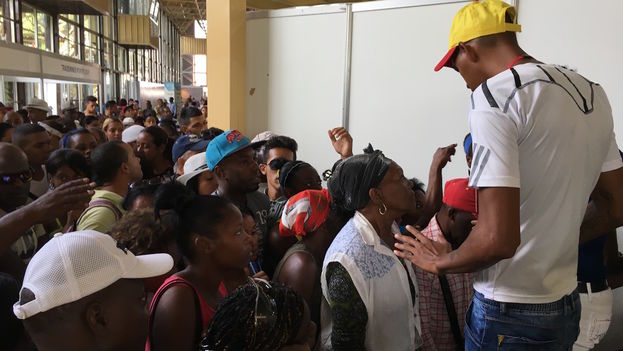
![]() 14ymedio, Mario Penton, Miami, 9 November 2016 – The control exercised by the Cuban military over a sector as critical as tourism was common knowledge. However, the recent International Fair of Havana (FIHAV 2016) uncovered that the Revolutionary Armed Forces (FAR) is not satisfied with a piece of the cake, they want the whole thing.
14ymedio, Mario Penton, Miami, 9 November 2016 – The control exercised by the Cuban military over a sector as critical as tourism was common knowledge. However, the recent International Fair of Havana (FIHAV 2016) uncovered that the Revolutionary Armed Forces (FAR) is not satisfied with a piece of the cake, they want the whole thing.
In contracts for hotel administration and marketing alone, of the 80 proposals Cuba presented in the last week as a part of the Portfolio of opportunities for foreign investment, 41 belong to the Gaviota SA group, owned by the FAR. But it is not only in numbers that the military takes most of the market, it is also in quality: 37 of the Gaviota proposals are 5-star hotels located on the most desirable plots on the island, in the midst of the greatest tourist boom in decades.
In total, Gaviota, which belongs to the Armed Forces Business Administration Group (GAE), is offering 18,768 rooms, the majority of them with a five-star or five-star-plus rating, compared to the 5,782 for Gran Caribe and 3,838 for Islazul, which depend on the Ministry of Tourism. A single night in one of Gaviota’s five star hotels ranges from 100 to 140 Cuban convertible pesos (roughly the same in dollars).
In the last two years the number of rooms and hotels with five-star ratings that Gaviota manages has not stopped growing.
“We are witnessing a slow-motion piñata that the Obama Administration is encouraging,” says Sebastian Arcos, a professor at the Cuban Research Institute of Florida International University (FIU).
For Arcos, the trade fair has made clear that the interest of Raul Castro’s government is not to solve the nation’s need for growth, “but its own oligarchic interests.”
“The Cuban economy has been militarized since the eighties and this fair confirms it,” he adds.
The International Fair of Havana is held every year in November. Since 2014 the Cuban government has been presenting a portfolio of opportunities to convince investors to do business with the island. This year the proposals have been on the order of 9.5 billion dollars.
The latest portfolio offers 395 projects gathered in 14 economic lines, among which Cuba prioritizes tourism, agri-food and energy. The document has 69 more initiatives than in 2015 and 149 more than in 2014.
Everleny Perez, one of the defenders in Cuba of the Raulista reforms, who was expelled from the Center for Studies of the Cuban Economy last April, says that basically the Fair was “more of the same.”
“Where are the 325 Cuban products exhibited? Where are they sold?” asked the doctor of economics who also questioned Cuba’s capacity to produce for a foreign importer, taking into account the difficulties in accessing raw materials in the Cuban market.
For Pérez, the absence of a real liquidity capacity on the part of Cuban companies hinders the negotiation process. “Foreigners exhibit products, but Cubans have no cash to buy them,” he says.
Cuban companies receive allocations in dollars from the Government for their transactions. These do not necessarily correspond to the profits of the company and limit its ability to buy.
Another important element, the economist says, is the number of proposals that have passed from one year to the next without finding investors.
The system of employment, whereby foreign companies contract directly with Cuban government employment agencies for workers, not with the workers themselves, is one of the brakes. The system discourages investors because they have to pay a high cost for labor, only about a third of which is paid to the workers with two-thirds retained by the Cuban government.
Despite three years since the appearance of the first portfolio of opportunities, projects such as a light car factory in Mariel, which would allow the manufacture of “a minimum” of 10,000 units, fail to pass from desire to reality.
“There are several obstacles to investment in Cuba, one of them is the slow pace of negotiations, which requires approval of the Council of Ministers or the State Council. How is it possible that a year later they have only laid the cornerstones of two factories in Mariel,” Perez asks, referring to the Mariel Special Development Zone and the Brascuba project of 100 million dollars as well as the Unilever project of 35 million.
Since the 2014 Law on Foreign Investment came into force, Cuba has approved 83 projects of around 1.3 billion dollars, a very distant figure from the 2.5 billion annually that the country needs to emerge from its economic coma; this year the country is not expected to reach a 1% growth rate in gross domestic product.
In the Mariel Special Development Zone just 19 projects are approved, of which only seven are in operation and none represents the large investments that were expected.
To Everleny Perez, “the country needs to return to the economic dynamics of changes that supposedly led to the coming to power of Raul Castro.”
For Sebastian Arcos, meanwhile, tomorrow will come to the Cuban economy through integration with the United States.
“That Cuba is less than an hour’s flight from the US cannot be changed by anyone, not even Fidel Castro. In the recognition of this natural market is the future of the island,” said Arcos.
